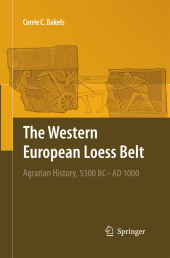 Neuerscheinungen 2014Stand: 2020-02-01 |
Schnellsuche
ISBN/Stichwort/Autor
|
Herderstraße 10
10625 Berlin
Tel.: 030 315 714 16
Fax 030 315 714 14
info@buchspektrum.de |

Corrie C. Bakels
The Western European Loess Belt
Agrarian History, 5300 BC - AD 1000
2009. 2014. viii, 295 S. 235 mm
Verlag/Jahr: SPRINGER NETHERLANDS; SPRINGER 2014
ISBN: 9400791364 (9400791364)
Neue ISBN: 978-9400791367 (9789400791367)
Preis und Lieferzeit: Bitte klicken
This book deals with the early history of agriculture in a defined part of Western Europe: the loess belt west of the river Rhine. It is a well-illustrated book that integrates existing and new information, starting with the first farmers and ending when food production was no longer the chief source of livelihood for the entire population. The loess belt was chosen because it is a region with only one type of soil and climate as these are all-important factors where farming is concerned.
Subjects covered are crops, crop cultivation, livestock and livestock handling, the farm and its yard, and the farm in connection with other farms. Crop plants and animals are described, together with their origin. New tools such as the plough, wheen, wagon and scythe are introduced. Groundplans of farm buildings, the history of the outhouse and the presence or absence of hamlets are presented as well, and the impact of farming on the landscape is not forgotten.
The loess belt was not an island and the world beyond its boundaries was important for new ideas, new materials and new people.
Summarising six millennia of agriculture, the thinking in terms of the Western European loess belt as one agricultural-cultural unit seems justified.
Preface 1 The loess covered region west of the river Rhine. 5300 BC - AD 1000 1.1 Introduction 1.2 Loess 1.3 The loess region 1.4 The choice of the period, 5300 BC - AD 1000 1.5 The framework of this book 2 Sources 2.1 Information on a distant past 2.2 Plants 2.3 Animals 2.4 Tools 2.5 Buildings and other structures 2.6 Land and countryside 2.7 Written sources 3 The beginning 5300 BC-4900 BC 3.1 The first farmers 3.2 Crops 3.3 Crop cultivation 3.4 Livestock and animal husbandry 3.5 Farm buildings and yards 3.6 The farm in its setting 4 Heirs to the first farmers 4900-4300 BC 4.1 The successors of the Linearbandkeramik culture 4.2 Crops 4.3 Crop cultivation 4.4 Livestock and animal husbandry 4.5 Farm buildings and yards 4.6 The farm in its setting 5 Innovation and expansion 4300-2650 BC 5.1 A new age 5.2 Crops 5.3 Crop cultivation 5.4 Livestock and animal husbandry 5.5 Farm buildings and yards 5.6 The farm in its setting 6 The first millennia of agricultural landscape 6.1 The original vegetation 6.2 The impact of the farming communities on the vegetation 6.3 Erosion 7 Towards a more complex society 2650 - 50 BC 7.1 The so-called Metal Ages 7.2 Crops 7.3 Crop cultivation 7.4 Livestock and animal husbandry 7.5 Farm buildings and yards 7.6 The farm in its setting 8 Part of the Roman Empire 50 BC - AD 407 8.1 Roman rule 8.2 Crops 8.3 Crop cultivation 8.4Livestock and animal husbandry 8.5 Farm buildings and yards 8.6 The farm in its setting 9 The Early Middle Ages D 407 - AD 1000 9.1 The end of Roman rule and thereafter 9.2 Crops 9.3 Crop cultivation 9.4 Livestock and animal husbandry 9.5 Farm buildings and yards 9.6 The farm in its setting 10 The birth of the rural landscape 10.1 The vanishing of the forest as the main vegetation type 10.2 Erosion 11 Summing up six millennia of agriculture Glossary Select bibliography Source of figures and tables Index


